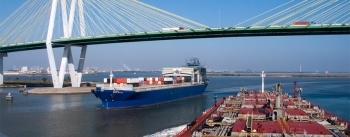May142014
Posted at 10:58 AM
By weight, 75 percent of U.S. international trade moves through the nation’s ports and harbors. Those ports support, directly and indirectly, more than 13 million American jobs.
NOAA provides environmental intelligence to support safe, efficient, and environmentally sound navigation through U.S. ports. NOAA produces the nation’s nautical charts, which provide essential navigation information such as water depths; locations of dangers to navigation; locations and characteristics of aids to navigation; anchorages; and other features.
NOAA also integrates ocean and coastal observations, data, science, and services to provide actionable information, thereby improving informed choices. Good decisions today protect lives and property tomorrow.
The agency monitors, assesses, and distributes tide, current, and water level products and services. Positioning information from NOAA provides a highly accurate, precise, and consistent framework to help mariners safely navigate around obstructions in our nation's busy waterways.
NOAA’s role warning coastal areas of hurricane threats is well known, but the agency also plays a significant role after the storm. NOAA moves quickly to help reopen ports. Navigation response teams survey ports and channels, searching for submerged debris and other dangers to navigation. NOAA aerial photography helps the public, decision makers, and insurance adjusters assess the extent of storm damage.
In addition, NOAA's Physical Oceanographic Real-time System (PORTS®) provides accurate real-time oceanographic information, tailored to the specific needs of local maritime communities. Knowledge of the currents, water levels, winds, and density of the water can increase the amount of cargo moved through a port and harbor by enabling mariners to safely utilize every inch of dredged channel depth. For example, an economic study showed that the Tampa Bay economy receives more than $7 million a year in savings and direct income from PORTS®. A second study calculated $16 million a year in savings for the Houston-Galveston region.
Learn more at http://oceanservice.noaa.gov/navigation/marinenav/



